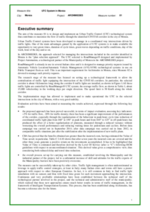Urban traffic control system
Thematic areas
Smart, Sustainable, Connected and Shared mobility
- Connected and automated transport
- Real-time road-user information
- ITS-based enhancement of public transport
- ITS for traffic
Summary
The aim of the measure is to design and implement an urban traffic control (UTC) system that contributes to optimising the flow of traffic through the city of Monza.
Implementing sustainable mobility
Monza is affected by a huge amount of traffic due to the vehicles that cross Monza to reach Milan. Prior to the measure, Monza had about 80 intersections equipped with traffic lights. This policy was no longer suitable to meet the requirements of a complex traffic control policy. In order to maximise the efficiency of the entire road network it is crucial to coordinate intersections.
The aim of the measure is to design and implement a UTC system that contributes to maximise the flow of traffic through the city of Monza. The use of real time location information gathered by the automatic vehicle location and monitoring (AVL/AVM) system is fundamental to increase the service level provided by the urban public transport.
Progress
The study to select the UTC system technical design has been completed.The first corridor consisting of eight intersections has been equipped after the tests have been successfully completed in project automation lab with the experts of the Municipality, such as the communications between Hydra Traffic Light Controller and the Industrial PC chosen to run new coordinated plans in the UTC environment.
A "Learning History Workshop" has been held with relevant stakeholders: top political representatives (Monza Mobility Councilor and City Manager), ARCHIMEDES Site Manager, Measure Leader, Municipality Traffic Engineers and Project Automation Traffic Technicians. During the workshop, drivers and barriers have been identified and discussed and future activities have been defined according to the scheduled workplan. After the analysis of the results of microsimulation, the experts of the Municipality decided the reference cycle times of the new traffic light plans for centralised control; 80 seconds in rush hours, 60 seconds in off-peak.
Each intersection put under control of the UTC system is under the control of a Central Computer; in ARCHIMEDES, the approach selected for managing the intersections included in the corridor identified in Monza is the “plan selection approach”, as described in deliverable T81.1. The UTC selected is RoadManager®, designed and implemented by Project Automation, technological partner of the Municipality of Monza in the ARCHIMEDES project.
The applications server for the UTC system has been equipped and configured in PA and the virtual private network (VPN) architecture has been arranged to guarantee the communication between the server and the Industrial PC. The system is currently being implemented. A good practice guide to bus management systems has been produced.
Outcomes
Evaluation activities have been aimed at measuring the results achieved, expressed through the following key results:
- the proposed approach has been proved successful, in terms of impact evaluation, assessing key indicators: +5% for traffic flow, -20% for traffic density; there has been a significant improvement of the performances of the corridor, especially through the regularisation of the behaviour in peak-hour; cycle time reduction of coordinated traffic light plan from 160” to 150” at peak hours and from 160” to 125” in off-peak hours has produced the effect of a better regularisation of platoons, measured through a reduced variance without worsening the overall performances and reducing waiting times for pedestrians and cyclists. Before data campaign was carried out in September 2011; after data campaign was carried out in June 2012, in comparable traffic situations just after the stabilization after the implementation of new traffic plans.
- CBA has proved that the benefits obtained are greater than the incurred costs, having estimated the Value of Time saved; in particular, Table C 2.6.10 shows that after seven years the incurred costs are covered and the other three years generate a positive return on the investments accomplished. It has to be highlighted that Value of Time is estimated and therefore derived by the Level Of Service (after is “C”) following HCM guidelines with respect to an uncoordinated situation . This derived value gives a comprehensive view, thus considering both reduced delay and travel time reduction.
- the overall process set-up for carrying out this measure, established involving the Municipality and the industrial partner of the project, led to a substantial increase of skill and attitudes for the traffic experts of the Municipality; barriers have been positively overcome;
The measure can be successfully taken-up by other cities. Traffic light management is often underestimated as leverage to apply traffic control strategies, at least in Italy; many Italian cities and towns still have a poorer approach with respect to other European Countries. In fact, it is still common in Italy to find traffic light installation with no sensors and thus with fixed time green for each movement approaching the intersection. Continuous and very profitable relationships have been established between the technical staff of the technological partner involved in the project, and the technical and administrative staff of the municipality; which realized that these new approaches ensure much better results in terms of traffic management, in the framework of Intelligent Transportation Systems. This process, that has been established along Archimedes, has become a reference also for the future.








